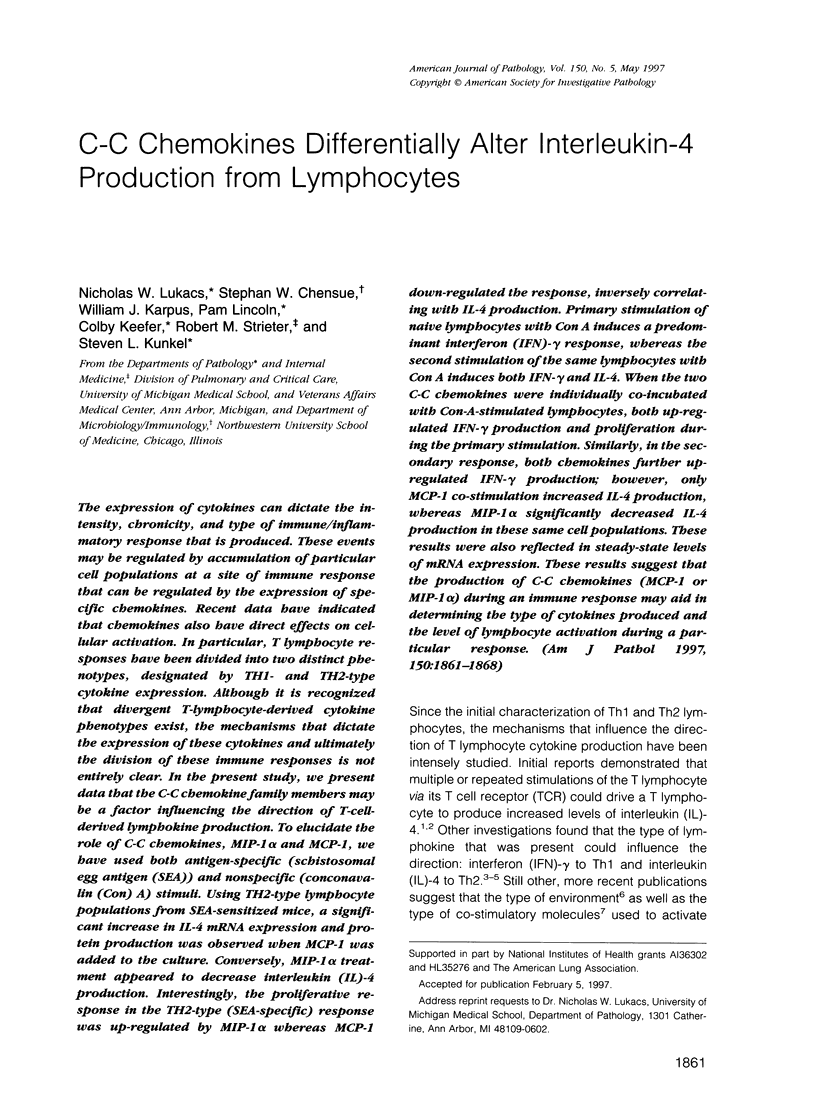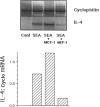Abstract
The expression of cytokines can dictate the intensity, chronicity, and type of immune/inflammatory response that is produced. These events may be regulated by accumulation of particular cell populations at a site of immune response that can be regulated by the expression of specific chemokines. Recent data have indicated that chemokines also have direct effects on cellular activation. In particular, T lymphocyte responses have been divided into two distinct phenotypes, designated by TH1- and TH2-type cytokine expression. Although it is recognized that divergent T-lymphocyte-derived cytokine phenotypes exist, the mechanisms that dictate the expression of these cytokines and ultimately the division of these immune responses is not entirely clear. In the present study, we present data that the C-C chemokine family members may be a factor influencing the direction of T-cell-derived lymphokine production. To elucidate the role of C-C chemokines, MIP-1 alpha and MCP-1, we have used both antigen-specific (schistosomal egg antigen (SEA)) and nonspecific (conconavalin (Con) A) stimuli. Using TH2-type lymphocyte populations from SEA-sensitized mice, a significant increase in IL-4 mRNA expression and protein production was observed when MCP-1 was added to the culture. Conversely, MIP-1 alpha treatment appeared to decrease interleukin (IL)-4 production. Interestingly, the proliferative response in the TH2-type (SEA-specific) response was up-regulated by MIP-1 alpha whereas MCP-1 down-regulated the response, inversely correlating with IL-4 production. Primary stimulation of naive lymphocytes with Con A induces a predominant interferon (IFN)-gamma response, whereas the second stimulation of the same lymphocytes with Con A induces both IFN-gamma and IL-4. When the two C-C chemokines were individually co-incubated with Con-A-stimulated lymphocytes, both up-regulated IFN-gamma production and proliferation during the primary stimulation. Similarly, in the secondary response, both chemokines further upregulated IFN-gamma production; however, only MCP-1 co-stimulation increased IL-4 production, whereas MIP-1 alpha significantly decreased IL-4 production in these same cell populations. These results were also reflected in steady-state levels of mRNA expression. These results suggest that the production of C-C chemokines (MCP-1 or MIP-1 alpha) during an immune response may aid in determining the type of cytokines produced and the level of lymphocyte activation during a particular response.
Full text
PDF







Images in this article
Selected References
These references are in PubMed. This may not be the complete list of references from this article.
- Alkhatib G., Combadiere C., Broder C. C., Feng Y., Kennedy P. E., Murphy P. M., Berger E. A. CC CKR5: a RANTES, MIP-1alpha, MIP-1beta receptor as a fusion cofactor for macrophage-tropic HIV-1. Science. 1996 Jun 28;272(5270):1955–1958. doi: 10.1126/science.272.5270.1955. [DOI] [PubMed] [Google Scholar]
- Bacon K. B., Premack B. A., Gardner P., Schall T. J. Activation of dual T cell signaling pathways by the chemokine RANTES. Science. 1995 Sep 22;269(5231):1727–1730. doi: 10.1126/science.7569902. [DOI] [PubMed] [Google Scholar]
- Bokoch G. M. Chemoattractant signaling and leukocyte activation. Blood. 1995 Sep 1;86(5):1649–1660. [PubMed] [Google Scholar]
- Boros D. L., Warren K. S. Delayed hypersensitivity-type granuloma formation and dermal reaction induced and elicited by a soluble factor isolated from Schistosoma mansoni eggs. J Exp Med. 1970 Sep 1;132(3):488–507. doi: 10.1084/jem.132.3.488. [DOI] [PMC free article] [PubMed] [Google Scholar]
- Charo I. F., Myers S. J., Herman A., Franci C., Connolly A. J., Coughlin S. R. Molecular cloning and functional expression of two monocyte chemoattractant protein 1 receptors reveals alternative splicing of the carboxyl-terminal tails. Proc Natl Acad Sci U S A. 1994 Mar 29;91(7):2752–2756. doi: 10.1073/pnas.91.7.2752. [DOI] [PMC free article] [PubMed] [Google Scholar]
- Chensue S. W., Terebuh P. D., Warmington K. S., Hershey S. D., Evanoff H. L., Kunkel S. L., Higashi G. I. Role of IL-4 and IFN-gamma in Schistosoma mansoni egg-induced hypersensitivity granuloma formation. Orchestration, relative contribution, and relationship to macrophage function. J Immunol. 1992 Feb 1;148(3):900–906. [PubMed] [Google Scholar]
- Chensue S. W., Warmington K. S., Lukacs N. W., Lincoln P. M., Burdick M. D., Strieter R. M., Kunkel S. L. Monocyte chemotactic protein expression during schistosome egg granuloma formation. Sequence of production, localization, contribution, and regulation. Am J Pathol. 1995 Jan;146(1):130–138. [PMC free article] [PubMed] [Google Scholar]
- Choe H., Farzan M., Sun Y., Sullivan N., Rollins B., Ponath P. D., Wu L., Mackay C. R., LaRosa G., Newman W. The beta-chemokine receptors CCR3 and CCR5 facilitate infection by primary HIV-1 isolates. Cell. 1996 Jun 28;85(7):1135–1148. doi: 10.1016/s0092-8674(00)81313-6. [DOI] [PubMed] [Google Scholar]
- Evanoff H. L., Burdick M. D., Moore S. A., Kunkel S. L., Strieter R. M. A sensitive ELISA for the detection of human monocyte chemoattractant protein-1 (MCP-1). Immunol Invest. 1992 Feb;21(1):39–45. doi: 10.3109/08820139209069361. [DOI] [PubMed] [Google Scholar]
- Grzych J. M., Pearce E., Cheever A., Caulada Z. A., Caspar P., Heiny S., Lewis F., Sher A. Egg deposition is the major stimulus for the production of Th2 cytokines in murine schistosomiasis mansoni. J Immunol. 1991 Feb 15;146(4):1322–1327. [PubMed] [Google Scholar]
- Jiang Y., Beller D. I., Frendl G., Graves D. T. Monocyte chemoattractant protein-1 regulates adhesion molecule expression and cytokine production in human monocytes. J Immunol. 1992 Apr 15;148(8):2423–2428. [PubMed] [Google Scholar]
- Karpus W. J., Lukacs N. W., McRae B. L., Strieter R. M., Kunkel S. L., Miller S. D. An important role for the chemokine macrophage inflammatory protein-1 alpha in the pathogenesis of the T cell-mediated autoimmune disease, experimental autoimmune encephalomyelitis. J Immunol. 1995 Nov 15;155(10):5003–5010. [PubMed] [Google Scholar]
- Kelso A. Th1 and Th2 subsets: paradigms lost? Immunol Today. 1995 Aug;16(8):374–379. doi: 10.1016/0167-5699(95)80004-2. [DOI] [PubMed] [Google Scholar]
- Kikuchi H., Hanazawa S., Takeshita A., Nakada Y., Yamashita Y., Kitano S. Interleukin-4 acts as a potent stimulator for expression of monocyte chemoattractant JE/MCP-1 in mouse peritoneal macrophages. Biochem Biophys Res Commun. 1994 Aug 30;203(1):562–569. doi: 10.1006/bbrc.1994.2219. [DOI] [PubMed] [Google Scholar]
- Kuchroo V. K., Das M. P., Brown J. A., Ranger A. M., Zamvil S. S., Sobel R. A., Weiner H. L., Nabavi N., Glimcher L. H. B7-1 and B7-2 costimulatory molecules activate differentially the Th1/Th2 developmental pathways: application to autoimmune disease therapy. Cell. 1995 Mar 10;80(5):707–718. doi: 10.1016/0092-8674(95)90349-6. [DOI] [PubMed] [Google Scholar]
- Lukacs N. W., Boros D. L. Lymphokine regulation of granuloma formation in murine schistosomiasis mansoni. Clin Immunol Immunopathol. 1993 Jul;68(1):57–63. doi: 10.1006/clin.1993.1095. [DOI] [PubMed] [Google Scholar]
- Lukacs N. W., Kunkel S. L., Strieter R. M., Warmington K., Chensue S. W. The role of macrophage inflammatory protein 1 alpha in Schistosoma mansoni egg-induced granulomatous inflammation. J Exp Med. 1993 Jun 1;177(6):1551–1559. doi: 10.1084/jem.177.6.1551. [DOI] [PMC free article] [PubMed] [Google Scholar]
- Neote K., DiGregorio D., Mak J. Y., Horuk R., Schall T. J. Molecular cloning, functional expression, and signaling characteristics of a C-C chemokine receptor. Cell. 1993 Feb 12;72(3):415–425. doi: 10.1016/0092-8674(93)90118-a. [DOI] [PubMed] [Google Scholar]
- Oppenheim J. J., Zachariae C. O., Mukaida N., Matsushima K. Properties of the novel proinflammatory supergene "intercrine" cytokine family. Annu Rev Immunol. 1991;9:617–648. doi: 10.1146/annurev.iy.09.040191.003153. [DOI] [PubMed] [Google Scholar]
- Post T. W., Bozic C. R., Rothenberg M. E., Luster A. D., Gerard N., Gerard C. Molecular characterization of two murine eosinophil beta chemokine receptors. J Immunol. 1995 Dec 1;155(11):5299–5305. [PubMed] [Google Scholar]
- Premack B. A., Schall T. J. Chemokine receptors: gateways to inflammation and infection. Nat Med. 1996 Nov;2(11):1174–1178. doi: 10.1038/nm1196-1174. [DOI] [PubMed] [Google Scholar]
- Röcken M., Müller K. M., Saurat J. H., Hauser C. Lectin-mediated induction of IL-4-producing CD4+ T cells. J Immunol. 1991 Jan 15;146(2):577–584. [PubMed] [Google Scholar]
- Röcken M., Müller K. M., Saurat J. H., Müller I., Louis J. A., Cerottini J. C., Hauser C. Central role for TCR/CD3 ligation in the differentiation of CD4+ T cells toward A Th1 or Th2 functional phenotype. J Immunol. 1992 Jan 1;148(1):47–54. [PubMed] [Google Scholar]
- Röcken M., Urban J., Shevach E. M. Antigen-specific activation, tolerization, and reactivation of the interleukin 4 pathway in vivo. J Exp Med. 1994 Jun 1;179(6):1885–1893. doi: 10.1084/jem.179.6.1885. [DOI] [PMC free article] [PubMed] [Google Scholar]
- Schall T. J., Bacon K., Toy K. J., Goeddel D. V. Selective attraction of monocytes and T lymphocytes of the memory phenotype by cytokine RANTES. Nature. 1990 Oct 18;347(6294):669–671. doi: 10.1038/347669a0. [DOI] [PubMed] [Google Scholar]
- Strieter R. M., Kunkel S. L., Bone R. C. Role of tumor necrosis factor-alpha in disease states and inflammation. Crit Care Med. 1993 Oct;21(10 Suppl):S447–S463. doi: 10.1097/00003246-199310001-00006. [DOI] [PubMed] [Google Scholar]
- Swain S. L., Huston G., Tonkonogy S., Weinberg A. Transforming growth factor-beta and IL-4 cause helper T cell precursors to develop into distinct effector helper cells that differ in lymphokine secretion pattern and cell surface phenotype. J Immunol. 1991 Nov 1;147(9):2991–3000. [PubMed] [Google Scholar]
- Swain S. L. IL4 dictates T-cell differentiation. Res Immunol. 1993 Oct;144(8):616–620. doi: 10.1016/s0923-2494(05)80013-6. [DOI] [PubMed] [Google Scholar]
- Swain S. L., Weinberg A. D., English M., Huston G. IL-4 directs the development of Th2-like helper effectors. J Immunol. 1990 Dec 1;145(11):3796–3806. [PubMed] [Google Scholar]




